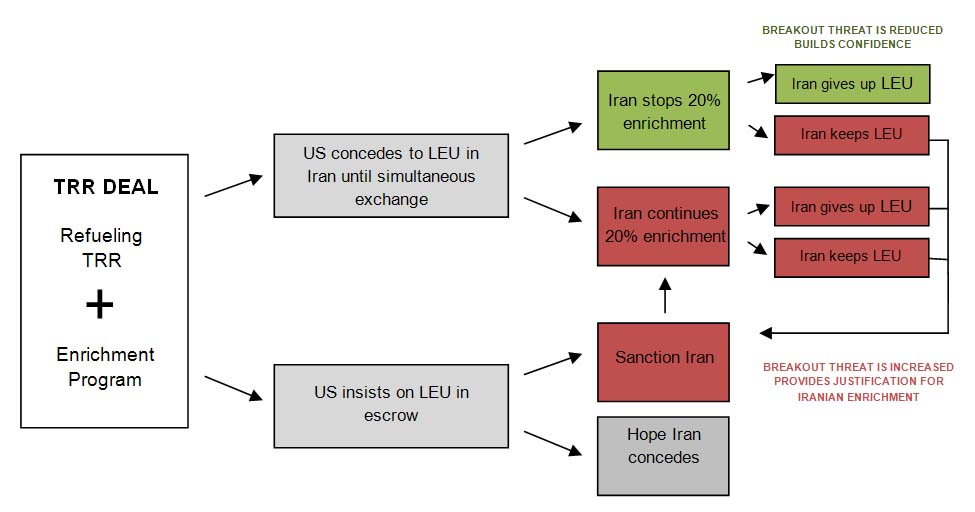Documentary “Paths to Zero” Premiering at the NPT RevCon
by: Alicia Godsberg
On Tuesday May 11 FAS will be premiering our documentary, “Paths to Zero,” at the United Nations during the 2010 Review Conference of the Parties to the Treaty on the Non-proliferation of Nuclear Weapons (NPT RevCon). The screening will be part of FAS’s official UN Office of Disarmament Affairs side event for the RevCon, which will be held from 10 am – 12 pm in Conference Room A of the North Building. To attend, you must be registered for the RevCon, but after the Conference FAS will be screening Paths to Zero in Washington, DC and we will be uploading the video to our website.
The world’s combined stockpile of nuclear weapons remains at a high and frightening level – over 24,000 – despite being two decades past the end of the Cold War. In the documentary film Paths to Zero, Federation of American Scientists Vice President Dr. Ivan Oelrich explains the history of how the nuclear-armed world got to this point, and how we can begin to move down a global path to zero nuclear weapons.
What’s Wrong with What’s Wrong with the Nuclear Posture Review
On Tuesday, the Secretary of Defense released the new Nuclear Posture Review (NPR). I was quite disappointed in the document, thinking it is timid and gradualist. So you can imagine how distracting it is when I am part way through writing a blog trashing the new doctrine for not going far enough that I see a flurry of articles about how the new doctrine goes way too far. So now I have to divert my valuable time to defending the NPR. (I will still finish the other blog, promise.) Some of the criticism is simply inane but most comes from not reading, or perhaps not even caring what’s in, the actual report. Still, it is probably a preview of the assaults to come.
Let’s begin with Sarah Palin, who said, “No administration in America’s history would, I think, ever have considered such a step that we just found out President Obama is supporting today. It’s kinda like getting out there on a playground, a bunch of kids, getting ready to fight, and one of the kids saying, ‘Go ahead, punch me in the face and I’m not going to retaliate. Go ahead and do what you want to with me.’”
Where does one start? Let’s begin with the big picture: Nuclear weapons are, by far, the most destructive instruments in human history, able to blow down entire cities within seconds, to kill millions at a shot, to end—quite literally—human civilization as we know it. Is a playground quarrel between a pair of schoolchildren a useful analogy? If we really wish to pursue the analogy then it would be more accurate to say that the NPR’s doctrine is equivalent to a child’s saying, “Even if you punch me, I will punch you back and perhaps beat you unconscious, I may even kill you, but I will not use a hand grenade to do it.” I believe that a no-hand-grenades-on-the-playground policy is something that many parents would endorse.
Ms. Palin is apparently assuming that by sometimes forgoing nuclear retaliation we remove all options. The NPR, in fact, states very clearly that countries that attack us with chemical or biological weapons will be met with devastating conventional attack. Moreover, the “negative security guarantees” that she is describing have long been an explicit or implicit part of U.S. nuclear doctrine.
A similar theme appeared when Sean Hannity interviewed Newt Gingrich on the NPR and other issues. In Hannity’s introduction, he says, “The Obama administration declared yesterday that the president plans to, well, depart from these precedents [of other Presidents’ nuclear policy]. Now, Secretary of Defense Robert Gates and Secretary of State Hillary Clinton announced that the president will not use nuclear weapons against any non-nuclear state, even in the event of a chemical or biological attack.”
This is not at all what the NPR says. The NPR specifically excludes states, whether nuclear or non-nuclear, that are not meeting their Non-Proliferation Treaty (NPT) obligations. Without explicitly listing their names there could not be a clearer reference to Iran and North Korea. So even if Iran never actually takes the final step of building a bomb, it is on the nuclear target list because we have declared that it is not in compliance with their NPT obligations. Moreover, the NPR reserves a big caveat: if future developments in biological weapons increase their effectiveness, then the United States will revisit this policy.
Like Palin, he later says, “So what he’s [Obama] saying here is that the United States will not even in self-defense, if there’s a biological, a chemical attack or a crippling cyber attack of some kind, that we’re not going to respond.” By Mr. Hannity’s definition, the United States did not “respond” to Pearl Harbor until it bombed Hiroshima.
Mr. Gingrich responded, in part, with “…I would love to see a White House reporter ask the simple question. If there was a biological attack, which killed over a million Americans, is this president really saying we would not retaliate?” Again, “retaliate” means apparently only nuclear retaliation and such a biological attack is, in any case, explicitly exempted (p. 16).
(These comments also show the dangers of the promiscuous use of the term “weapons of mass destruction.” We now call cyber attacks and truck bombs “WMD” and conflate them with nuclear weapons that can blow down cities. This bundled term confuses more than it enlightens and should be eliminated from any discussion of national strategy.)
Mr. Hannity goes on to say, “Now, beyond that, the United States will not develop any new nuclear weapons.” I wish I could agree with his interpretation here but I cannot. The NPR says that “The United States will not develop new nuclear warheads.” It states that warheads will be maintained by Life Extension Programs, with a strong preference for refurbishment and some replacement but each warhead will be considered on a case-by-case basis and some nuclear components could be replaced with components from different warheads not necessarily in the current stockpile. By my definition, that would be a “new” warhead but not by the NPR definition. The only restriction is that nuclear components would have to have to be based on tested components but that would not, I believe, disqualify the recent Livermore Reliable Replacement Warhead (RRW) design.
John Bolton writes that “The Nuclear Posture Review is deeply troubling in many respects, starting at the conceptual level with its unfounded assertion that the need for American nuclear deterrence has declined.” It is difficult to imagine what the definition of “need” is here. During the Cold War, nuclear “deterrence” included the threat of a disarming first strikes against Soviet central nuclear forces to deter a conventional attack on NATO by Soviet tank armies poised west of Berlin. The growing capability of conventional weapons is making nuclear weapons obsolete for most missions. Can anyone believe the need for nuclear deterrence has not declined? (Perhaps he means it has not declined in the last few years?) Russia and the United States still have a couple of thousand nuclear weapons pointed at each other but not because of any conflict existing today but because of momentum left over twenty years after the end of the Cold War.
Keith Payne worries that declaring that a policy of not threatening nations in compliance with the Non-Proliferation Treaty implies that the IAEA board of governors, which determines question compliance, will determine U.S. nuclear policy. As Frank Gaffney puts it, “The paramount question is: Who will determine whether a state is complying with the treaty?” Well, if he were really interested he could always ask that question and, indeed, it has been asked of the authors of the NPR and the answer is that the only thing that matters is whether the United States, not the IAEA, believes the nation in question is in compliance.
Charles Krauthammer muddles historical analysis and the current doctrine. He writes that “During the Cold War, we let the Russians know that if they dared use their huge conventional military advantage and invaded Western Europe, they risked massive U.S. nuclear retaliation.” Seeing that the lack of such attack proves that deterrence worked, he argues that we should, therefore, not change our doctrine. But the part of the doctrine relevant to his example would not change, the United States can still attack Russia, a nuclear power, with nuclear weapons and, in fact, the NPR makes clear that Russia is our largest nuclear target. In cases where the doctrine would change—forgoing attack on non-nuclear nations—the deterrence story is not so clear: Korea, Vietnam, and Iraq were not deterred even by America’s unilateral possession of nuclear weapons so his historical analysis seems at best to be irrelevant if not contradicted.
After explaining that the new doctrine would exempt NPT-compliant nations from nuclear attack, he writes “This is quite insane. It’s like saying that if a terrorist deliberately uses his car to mow down a hundred people waiting at a bus stop, the decision as to whether he gets (a) hanged or (b) 100 hours of community service hinges entirely on whether his car had passed emissions inspections.” It is the analogy that is so over the top as to be insane but it brings up the question of why the U.S. might have different responses under different circumstances. If we tone down his childish exaggeration, criminal penalties do, in fact, vary depending on circumstances. For example, many states have more severe penalties for a crime if the perpetrator had a gun, even if the gun was not used. Why? Because society has an interest in discouraging gun violence, so we make having the gun, and the potential for gun violence, cause for a greater penalty. (Now one could turn that around and say with indignant incredulity that we are giving a criminal some sort of reward for not using a gun even though he committed the very same crime rather than greater punishment for using a gun but clearly these amount to the same thing.) Most people would agree this policy makes some sense. Similarly, is it not in the interest of the United States to discourage nations from acquiring nuclear weapons? And isn’t it reasonable to create incentives? In this context, Mr. Krauthammer misrepresents the meaning of NPT compliance when he writes “If it turns out that the attacker is up to date with its latest IAEA inspections, well, it gets immunity from nuclear retaliation.” This is, of course, wrong. Iran is “up to date with its latest IAEA inspections” but it is not compliant with the NPT. “Compliant with the NPT” is a surrogate for not having a nuclear weapons program and discouraging that is in the greater, long-term interest of the United States. This sort of wild exaggeration and cavalier misrepresentation does a disservice to the national debate about a serious topic.
At least he does not make the mistake of implying that no nuclear response equals no response at all when he says, “Our response is then restricted to bullets, bombs and other conventional munitions.” I will simply remind the reader that this would describe, for example, the Second World War.
I could go on (and, alas, on) but I will close with a Washington Times column by Jeffrey T. Kuhner. His article is also filled with wild exaggeration and I will only cite one of his points. The NPR supposedly puts unacceptable limitations on the maintenance and modernization of U.S. nuclear weapons. He writes, “Moreover, the NPR stipulates that the United States will not modernize its nuclear weapons systems; rather, Washington will rely upon its aging warheads and nuclear infrastructure. China and Russia have gained a decisive advantage in pursuing innovative nuclear weapons technology.” This is flagrant misrepresentation of what is actually in the document. The NPR clearly states that weapons will be maintained and even upgraded. The only stipulation being that we will only use nuclear components with a proven test pedigree, a prudent design philosophy that most weapons designers fully support, including the directors of all three weapons labs. Moreover, the Pentagon is already in the early planning stages for new ballistic missile submarines, intercontinental ballistic missiles, and a new nuclear-capable strategic bomber. The budget for the national labs is increasing. And to his last point, Mr. Kuhner should ask any U.S. weapons designer or military nuclear specialist whether they would trade the Russian arsenal for America’s. The answer will in all cases be no. (And China? Please.)
I have presented this sample of objections to the NPR because this may be, I am afraid, representative of the “debate.” We can only hope for a more mature discussion of the issues. I strongly recommend Peter Feaver’s op-ed in the New York Times. I know Peter and he is a thoughtful, intelligent, and absolutely reasonable fellow and he does not support Obama’s NPR. But he argues that, while the NPR goes in the wrong direction, it is, on balance, a fairly modest document that, regardless of what direction it goes, does not go very far at all from past positions. I agree, which I say with some regret because I wanted it to go further.
Twenty Percent Solution: Breaking the Iranian Stalemate
by Ivanka Barzashka and Ivan Oelrich
Iran and the rest of the world are stalemated. Obama’s deadline for Tehran to address concerns about its nuclear program passed at the end of 2009, so the White House is moving to harsher sanctions. But the US is having trouble rallying the needed international support because Iranian intentions remain ambiguous. The deadlock includes negotiations on fueling Iran’s medical isotope reactor. With no progress on that front, Iran has begun its own production of 20-percent uranium for reactor fuel, a worrying development that could put Iran closer to a nuclear weapon. Yet, even while talk of sanctions escalates, Tehran says it is still interested in buying the 20 percent reactor fuel from foreign suppliers.
The Tehran Research Reactor (TRR) deal has backfired. The offer, to trade a large part of Iran’s low enriched uranium (LEU) for finished TRR fuel elements, was meant to abate the potential Iranian nuclear threat by reducing Iran’s stockpile of enriched nuclear material. By artificially coupling two distinct problems, re-fueling the TRR and Iran’s enrichment program, the US, France and Russia have given Tehran a reason, even a humanitarian one, to enrich to higher concentrations. The move to 20 percent enrichment will reduce by more than half the time needed for Iran to get a bomb’s worth of material. (more…)
The Nuclear Posture Review
 |
| The Nuclear Posture Review enshrines nuclear disarmament as a real goal for U.S. nuclear weapons policy for the first time. |
By Hans M. Kristensen
It’s finally here! Hot off the press after a three months delay. For the first time since the end of the Cold War, the United States has published a Nuclear Posture Review report.
Granted, it’s a sanitized version, but the Obama administration’s Nuclear Posture Review (NPR) contains strong language that commits the United States to work for nonproliferation. And for the first time, the goal of elimination of nuclear weapons is enshrined into the NPR.
By incorporating a broader range of policy issues in setting the nuclear posture, the review represents a break with the Bush administration’s NPR, which was more focused on military capabilities. As such, the new NPR is more a nuclear policy review than a nuclear posture review.
At the same time, the new NPR comes across as a surprisingly cautious document that recommends curtailing the U.S. nuclear posture further in the future but for now preserves many of the key nuclear weapons force structure and policy elements of the previous administration.
Proliferators and Peer Adversaries
The truly new in this NPR is that a good portion of it has very little to do with the U.S. nuclear posture and more to do with policies intended to curtail the spread of nuclear weapons to others. As such, this NPR has a much broader horizon than previous versions. A much needed update.
The NPR illustrates how proliferation has had and continues to have a real effect on U.S. nuclear weapons policy. This is most vivid in the sections dealing with the role of nuclear weapons and regional deterrence.
In the end, however, the NPR illustrates that proliferation is a side-chapter for the sizing and characteristics of the U.S. nuclear posture, which continues to be dominated by planning against Russia and China.
As such, it is in the regional mission that most of the change that President Obama has promised may eventually emerge.
Clarifying the Nuclear Carrot
The NPR adopts a much needed simplification and clarification of the U.S. negative security assurance, an important “carrot” intended to help persuade countries not to acquire nuclear weapons. This is not a new policy by any means, but the NPR surely clarifies it:
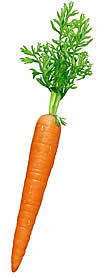 |
| The NPR clarifies and simplifies the “nuclear carrot” |
The “United States will not use or threaten to use nuclear weapons against non-nuclear weapons states that are party to the Nuclear Non-Proliferation Treaty and in compliance with their nuclear non-proliferation obligations.”
Compare that to the Cold War version most recently repeated by the Bush administration in 2002:
The United States “will not use nuclear weapons against non-nuclear weapon states parties to the Treaty on the Nonproliferation of Nuclear Weapons [NPT], except in the case of an invasion or any other attack on the United States, its territories, its armed forces or other troops, its allies or on a state toward which it has a security commitment, carried out or sustained by such a non-nuclear weapon state in association or alliance with a nuclear weapon state.”
Oy ve! There were so many exemptions buried in the old version that it was hard to understand what it meant. The new version fixes that: sign and abide by the NPT and you’re covered!
Yet as soon as you begin thinking about how this policy would be applied in the real world, questions arise.
Take Iran, for example, a non-nuclear weapon state that has signed the NPT, but is not – how to say it – on the best terms with the regime. How much in breach of its obligations under the NPT does Iran have to be before the policy kicks in? In other words, at what point would the president decide to include or exclude Iran from the list of potential adversaries he orders the military to plan nuclear strikes against?
Likewise, the negative security assurance only relates to Iran’s nuclear status. But Iran is already a target for U.S. nuclear planning because of its chemical and biological weapons capabilities. And as the NPR makes clear, U.S. nuclear weapons continue to play a role in deterring chemical and biological weapons. So could a country that has signed the NPT and abide by its obligations still be a target because it has chemical and biological weapons? In other words, which part of the policy rules?
Reducing the Role of Nuclear Weapons?
President Obama pledged in his Prague speech last year that he would “reduce the role of nuclear weapons” to “put an end to Cold War thinking,” and reaffirmed in February this year that the “Nuclear Posture Review will reduce [the] role….”
At a first glance the NPR appears to reduce the role of nuclear weapons. The document states in the executive summary that, the “fundamental role of U.S. nuclear weapons is to deter nuclear attack on the United States, our allies, and partners.” (They’ll probably have to add “U.S. forces” to that list.)
While most of the debate so far has focused on what “fundamental” means, I think the important part of that statement is the word “nuclear.” Because the two previous administrations used a broader role: to deter weapons of mass destruction attacks. Weapons of mass destruction (WMD) is a much broader category that includes nuclear, biological, chemical, and radiological weapons. Nuclear strike plans against regional adversaries armed with WMD were added to the strategic war plan in 2003.
Under the section “Reducing the Role of U.S. Nuclear Weapons” the NPR lists three overall conclusions about the role:
- The United States will continue to strengthen conventional capabilities and reduce the role of nuclear weapons in deterring non-nuclear attack, with the objective of making deterrence of nuclear attack on the United States or our allies and partners the sole purpose of U.S. nuclear weapons.
- The United States would only consider the use of nuclear weapons in extreme circumstances to defense the vital interests of the United States or its allies and partners.
- The United States will not use of threaten to use nuclear weapons against non-nuclear weapons states that are party to the NPT and in compliance with their nuclear proliferation obligations.
The “deter nuclear attack” and pursuit of “sole purpose” is clearly new language, and they would, if implemented, constitute a roll-back of the Clinton and Bush administrations’ policy of using nuclear weapons to deter all forms of WMD.
But a little further into the document, it soon becomes clear that the actual reduction in the nuclear mission – at least for now – is rather modest, if anything at all. In fact, it’s difficult to see why under the language used in this NPR, U.S. nuclear planning would not continue pretty much the way it is now.
 |
| The NPR appears to continue nuclear planning against regional adversaries with weapons of mass destruction |
The NPR explicitly rejects the adoption of a “sole purpose” policy for now, and leaves it up to future presidents to possibly change the policy in that direction. The price for a “sole purpose” policy, it seems, is more conventional weapons.
Changes in the role of nuclear weapons are much harder to see when it comes to Russia and China, where the NPR appears to continue the Bush administration’s policies. The retention of the Triad and an upload capability seem explicitly tied to those scenarios. Indeed, the NPR bluntly states that “Russia’s nuclear force will remain a significant factor in determining how much and how fast we are prepared to reduce U.S. forces.”
The first test of how and when the role of U.S. nuclear weapons might be reduced will come in a few months when president Obama issues his first presidential directive with nuclear weapons planning guidance to the military. The U.S. nuclear war plan is currently based on NSPD-14 from June 2002.
Reducing the Number of Nuclear Weapons?
President Obama also pledged in the Prague speech that he would “reduce the number of nuclear weapons” to “put an end to Cold War thinking.”
The NPR force structure analysis was the basis for the New START limits of 1,550 deployed strategic warheads and 700 deployed strategic delivery vehicles. Those limits represent a reduction compared with previous limits set by the 1991 START and 2002 Moscow Treaty.
But, as I’ve said earlier, and president Obama acknowledged in his interview with the New York Times, the New START reduces the limit for how many warheads can be deployed but not the actual number of warheads in the arsenal.
Surprisingly, the NPR does not identify how the New START limits will be achieved. Potential areas for the reductions are: a retirement of two SSBNs from the nuclear mission; a cut of about 50-100 additional Minuteman III ICBMs; conversion of some of the B-52s to conventional-only aircraft.
The NPR continues the conversion of the ICBM force to single-warhead configuration. That decision implements a decision made by the 1994 NPR, but which the Bush administration modified to allow for a few ICBMs to continue to carry multiple warheads. They were not many, though, so the reduction in warheads from finishing the conversion will be modest, although a decision to reduce the number of ICBMs further would increase the reduction.
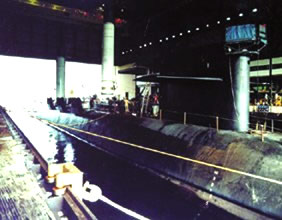 |
| The NPR and START “will not affect the number of deployed nuclear warheads on SSBNs” |
One apparent example of the effect of not counting bomber weapons under the START ceiling is the NPR decision that even a retirement of two SSBNs “will not affect the number of deployed nuclear warheads on SSBNs.”
The NPR does not clearly direct a reduction in the size of the total nuclear weapons stockpile, which currently contains about 5,000 warheads. The Bush administration reduced the stockpile by nearly 50 percent between 2004 and 2007, and announced an additional 12 percent reduction by 2012, leaving about 4,600 warheads.
A change might come from a reduction in the inventory of non-deployed warheads. The Bush administration’s decision in 2001 to retain a Responsive Force of reserve warheads that can be loaded back onto missiles and bombers if necessary received a lot of criticism for making a mockery of arms cuts. There are currently an estimated 2,500 active warheads in that hedge. The new NPR says that the U.S. will “significantly reduce” the size of the hedge, but that the United States will retain the ability to ‘upload’ some nuclear warheads as a technical hedge against any future problems with U.S. delivery systems or warheads, or as a result of a fundamental deterioration of the security environment.” Whether the reduction will happen unconditionally or be dependent on Congressional approval of new bomb factories is unclear, but it appears to depend on construction of the new facilities.
Overall, the NPR retains the Cold War force structure of nuclear weapons deployed on a Triad of delivery vehicles and concludes that, “the current alert posture of U.S. strategic forces – with heavy bombers off full-time alert, nearly all ICBMs on alert, and a significant number of SSBNs at sea at any given time – should be retained for the present.” President Obama’s campaign pledge to “work with Russia to take U.S. and Russian ballistic missiles off hair trigger alert” appears to have been put on hold.
No doubt, retaining a Cold War posture with only modest reductions and delaying decisions about where the cuts will fall will help win crucial votes in the Senate for ratification of the New START treaty and the CTBT.
With the modest reductions recommended by this NPR, the report states that president Obama has already directed a review of future reductions of nuclear weapons. But potential reductions are conditioned on further strengthening regional deterrence, maintain strategic stability with Russia and China, provide nuclear umbrellas over allies, and building new bomb making factories.
Extended Deterrence and Nuclear Weapons
The NPR does a good job of underscoring that extended deterrence is much more than nuclear weapons. There has been an unfortunate tendency in the public debate to equate extended deterrence for NATO allies with a need to forward deploy tactical nuclear weapons in Europe.
Unfortunately, the NPR does not recommend reducing or withdrawing the approximately 200 nuclear bombs currently deployed at six bases in five European countries. Instead, it says the U.S. “will consult with our allies regarding the future basing of nuclear weapons in Europe, and is committed to making consensus decisions through NATO processes.” This is probably intended to formally leave a decision to NATO’s Strategic Review process scheduled for completion in November.
For a document that emphasizes nonproliferation and adherence to NPT obligations, the description of “NATO’s unique nuclear sharing arrangements under which non-nuclear members participate in nuclear planning and possess specially configured aircraft capable of delivering nuclear weapons” does come across as somewhat out of sync. Training and equipping non-nuclear countries to deliver nuclear weapons is not a standard the Obama administration should support.
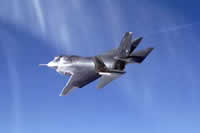 |
| The NPR recommends production of a new nuclear fighter (F-35) with a new nuclear weapon (B61-12) |
Regardless of what NATO might decide, the NPR concludes that some of the Joint Strike Fighters (F-35) will be equipped to deliver the new B61-12 nuclear bomb to “retain the capability to forward-deploy non-strategic nuclear weapons in support of its Alliance commitments.” So even if NATO decides the weapons can be withdrawn, a tactical nuclear fighter capability will remain.
Nuclear Tomahawk sea-launched land-attack cruise missiles (TLAM/Ns) that previously supported extended deterrence of NATO and Pacific allies will be retired and the NPR correctly concludes that the remaining nuclear forces provide amble capability to both signal and deter. This brushes aside warnings from the Congressional Strategic Posture Commission and others. As for the future role of nuclear weapons in regional scenarios, the NPR states:
“U.S. nuclear weapons will play a role in the deterrence of regional states so long as those states have nuclear weapons, but the decisions taken in the NPR, BMDR, and QDR reflect the U.S. desire to increase reliance on non-nuclear means to accomplish our objectives of deterring such states and reassuring our allies and partners.”
Warhead Dismantlement and Production
There are currently about 4,500 retired nuclear warheads in queue to be dismantled. At the low dismantlement rate currently used (200-400 warheads per year) it will take more than decade to dismantle the backlog. More retired warheads will come from the decision to “significantly reduce” the hedge, further extending the timeline.
Dismantlements compete with warhead maintenance and production for limited capacity at the Pantex Plant in Texas. The NPR recommends full-rate production of the W76-1 warhead, followed by the B61-12, and possibly the W78.
These programs are described as extending the lives of existing warhead designs, although modifications can be significant. The NPR pledges that
“The United States will not develop new nuclear warheads. Life Extension Programs will use only nuclear components based on previously tested designs, and will not support new military missions or provide for new military capabilities.”
This policy leaves the door open for extensive modifications of nuclear warheads – it would even permit production of the Reliable Replacement Warhead (RRW), although officials insist that program is “dead” – and the NPR states that the full range of warhead work will be considered: refurbishment of existing warheads, reuse of nuclear components from different warheads, and replacement of nuclear components.
Mindful of how controversial a decision to build replacement warheads is, the NPR assures that decisions to modify warheads “will give strong preference to options for refurbishment or reuse” rather than replacement.
Conclusion
The NPR elevates nonproliferation to the same level in U.S. nuclear policy as the nuclear weapons posture. It enshrines eventual nuclear disarmament as a central goal for U.S. nuclear weapons policy for the first time, and it sets the stage for possible future reductions in the role and numbers of nuclear weapons.
For those of us who looked forward to the NPR to clearly and significantly reduce the role and numbers of nuclear weapons, however, the report is a disappointment. President Obama has cautioned that his vision of a nuclear free world might not happen in our lifetime and the NPR shows why he might be right.
The options for how to reduce nuclear weapons are vague in the NPR but probably buried in the classified version. Some of those options, including how deep many reserve warheads will be retired, and how many ICBMs, SSBNs and bombers will be cut, will be made in the months and years ahead.
Above all, the NPR is a pragmatic policy document that combines maintaining a strong nuclear arsenal, modest reductions in nuclear weapons, nonproliferation efforts, and a vision of a world free of nuclear weapons to position the Obama administration for the April Nuclear Summit, the May NPT Review Conference, and ratification of the New START treaty and Comprehensive Test Ban Treaty.
Successful outcomes of those milestones are essential for the prospects of future reductions in the role and number of nuclear weapons, as is honest critique of when initiatives don’t go far enough.
There is a risk here, of course, that after having galvanized international hopes and expectations about dramatic changes to decisively move the world toward nuclear disarmament, the modest NPR instead will be seen by the international community as a sign that Cold Warriors managed to block much of president Obama’s vision.
Hopefully that won’t happen, but there sure is a lot of work ahead.
Further Reading: 1994 NPR | 2001 NPR
This publication was made possible by a grant from Carnegie Corporation of New York and Ploughshares Fund. The statements made and views expressed are solely the responsibility of the author.
Hardly a Jump START
Four months past a “deadline” imposed by the expiration of the old START treaty and amid much fanfare, President Obama announced that he and Russian President Medvedev had agreed on a new arms control treaty. I am not as excited as most are about the treaty and much of the following might be interpreted as raining on the parade so let me begin by saying that the negotiation of this treaty is an important step. While not as big a step as I had hoped for, it is an essential step.
Whatever the actual reductions mandated by the treaty—and they are modest—it was vital to get the United States and Russia talking about nuclear weapons again. The U.S. and Russia have at least 95% of the world’s nuclear weapons and they have to lead the world in nuclear reductions. Without this first step there cannot be a second step and there are many steps between where we are today and a world free of nuclear weapons.
The Bush administration did not simply dismiss arms control as irrelevant but argued that negotiating agreements was actually counter productive, potentially creating confrontation where it would not otherwise arise. Avoid talking and let sleeping dogs lie was the philosophy. The Bush administration had the best of both worlds, from its perspective, by negotiating the nearly meaningless Strategic Offensive Reduction Treaty, SORT, sometimes called the Moscow Treaty, that simply allowed each side to declare their plans for what they were going to do anyway and contained no verification provisions.
This treaty is different. The White House has released summaries of the main features of the treaty, not the full text, but it is clear this is a real treaty with real limits and real verification. This treaty and, more importantly, the process that produced it, gets the arms control train back on the track.
Even so, this treaty is a modest step. Hans Kristensen has described the numbers and their implications for the nuclear force structure. The treaty makes some modest reductions from the SORT limits but not large enough changes to make a qualitative difference in the nuclear standoff between the legacy forces of the two Cold War superpowers. (If anyone can explain to me why we and the Russians continue to need over a thousand nuclear bombs, each five to twenty five times more powerful than the bomb that flattened Hiroshima, pointed at each other, please send me an email. I want to know what the beef between us is that makes that seem proportionate.)
The treaty does not even approach territory that would call for a fundamental rethinking of how we deploy our nuclear weapons. As the military would say, the treaty protects the force structure. That is, we will still have a triad of bombers and both land-based and sea-based ballistic missiles, another obsolete artifact of the Cold War that dates back to fears of a disarming first strike from the Soviet Union (and inter-Service competition). Even Air Force advocacy groups such as the Mitchell Institute have considered eliminating the nuclear mission for the manned bomber and moving from a triad to a dyad of land- and sea-based missiles. In fact, the treaty contains a peculiar counting rule that increases the importance of bombers: each bomber counts only as one nuclear bomb although the B-52 can carry 20 nuclear-armed cruise missiles and the Russian bombers, for example the Backfire and Blackjack, have similar payloads. If we define corn as a type of tree, then suddenly Iowa would be covered in forests. If we define a bomber with 20 bombs as a single bomb, then suddenly we get a substantial reduction in the nuclear of weapons. (Hans discusses the numbers in more detail.) This rule reportedly resulted from Russia’s refusal to allow the necessary on-site inspections at its bomber bases but it creates an important caveat on any claim of “reductions.”
The treaty apparently does not address in any way nuclear weapon alert levels. Most of the deployed weapons both sides will have under the treaty will be continuously ready to launch within minutes. The treaty does nothing to restrict both nuclear powers to a no-first-use capability. If we wanted to reduce the threat that Russia and the U.S. pose to one another, we would be far better off to ignore the numbers of weapons but take weapons off alert so the current treaty has that exactly wrong.
Non-deployed warheads are not covered by the treaty at all as far as I can tell from the summaries. Both sides will still retain thousands of nuclear weapons not mounted on missiles and these are not even counted, much less limited, by the treaty. Apparently the verification of reserve warhead limits was too intrusive. While inspection of warhead dismantlement facilities is allowed, I cannot tell from the summary exactly what is going to be verified. I believe that the dismantlement itself will not be monitored.
One of the strengths of the treaty is that it limits actual missile warheads and provides for the verification of deployed missile warheads. In the past, there has been no way to verify warhead numbers so treaties resorted to “counting rules,” that is, those things that could be counted, namely bombers, submarines, and missile silos, were counted and each launcher was simply assumed to have a certain number of nuclear warheads associated with it. For example, if a type of missile had been tested with eight warheads, then all missiles of that type would be counted as having eight warheads regardless of the number actually mounted on top. Thus, in previous treaties, limits on the number of warheads were indirect. With this treaty, on-site inspections will allow each side to confirm though a limited number of spot-checks the number of missile warheads actually mounted on missiles.
The U.S. has wanted to keep the number of launchers high while accommodating modest reductions in the number of warheads. It has done this up to now by removing (or off-loading) warheads from multiple warhead missiles. The Russians have objected that this creates worrying breakout potential: the U.S. could reactivate reserve warheads and quickly mount them back atop the existing missiles, called uploading. In a crisis, this creates instability: if the one side sees the other uploading warheads, there is a strong incentive to strike before the process can proceed to completion. This is the argument the Russians used for limits on launchers. (Plus, of course, the Russians are short of money and want to reduce the number of their missiles anyway so better to get the Americans to come along with them.) The U.S. accepted the Russian launcher number but was unwilling to proportionately cut warheads. This creates a ratio of launchers and warheads that is not terrible but could be better. Having several warheads atop each missile makes them relatively more attractive targets of a disarming surprise first strike; this is called first strike instability. So the conflicting goals of Russia and the U.S. have forced them into trading one form of crisis instability for another. Note that, if reserve warheads were verifiably eliminated, the Russian fear of uploading would be addressed.
Given the very modest nature of the treaty, it should sail through ratification, in a normal political climate. But this is not a normal political climate. As Secretary Clinton pointed out, past arms control treaties have been ratified by the Senate by 90 votes or more. But after the passage of the health care bill, the Republicans may be unwilling to give President Obama a foreign policy success. Senator McCain has said that there will be no more cooperation in the Senate for the rest of the year. We shall see. But clearly, the Senate Republicans’ no-compromise tactics may doom treaty ratification. One thing seems certain to me: the Republicans have shown remarkable party discipline in the Senate so treaty ratification will either fail or it will succeed with close to one hundred votes. It depends on a political decision by the minority caucus.
I did not attend the White House briefing on the treaty but Hans did and reports that, according to the administration, many shortcomings of the treaty resulted from Russian resistance to intrusive verification measures. If true, this bodes ill for future dramatic achievements, for example, limits on non-deployed warheads or verifying the dismantlement of nuclear warheads. The Russians may, in part, be cautious about intrusive verification because it might reveal strategic vulnerabilities. If this is so, then the U.S. could do much to allay those fears by moving away from a counterforce capability that threatens Russian central nuclear forces every minute of the day.
After all this complaining, I have to repeat my first point: this is an important treaty, it gets us back on track, it should be welcomed, and ratified. I wish it had been bolder, I wish it had taken bigger steps, I wish it had made qualitative as well as quantitative changes, but it moves entirely in the right direction.
What next? This has long been described as a transitional treaty. It was meant to be a bridge between the expired START treaty and the next treaty, which is going fundamentally reshape the nuclear relationship of the Cold War legacy nuclear powers. We can hope so. The treaty has a ten-year lifetime with the option to extend for another five. If this is all we do for the next decade, it will, indeed, be disappointing. We cannot think we are done, these laurels are far too small to rest on comfortably. This treaty must be considered what it was sold as a year ago: a stopgap to paste over the expiration of START while the transformational treaty is negotiated. Alas, given the difficulty of negotiating this modest instrument, it may take ten years to get the next treaty.
If this treaty is a preview of the soon-to-be released nuclear posture review (NPR), then we will know that transformation of the nuclear danger is merely a theoretical aspiration not an actual goal of the administration. If, on the other hand, the NPR calls for unilaterally reducing the alert rate of our nuclear forces, reduces the counterforce emphasis on nuclear weapons and their deployment, and lays out clear steps the U.S. intends to take soon toward a world free of nuclear weapons, then it could form the basis for a truly transformational next treaty with Russia. Much of the wariness of the Russians is perfectly justified by the constant treat of a disarming U.S. first strike. We have to change that reality first and then we can institutionalize it with a treaty.
Also, we must carefully weigh the domestic political price tag that the treaty is going to carry. Even before the this treaty got out of the gate, or the Comprehensive Test Ban Treaty was warmed up, the administration came in with a budget that included a $700M top up to the national labs. This was widely considered a minimum down payment to get the labs and conservative Senators on board supporting the treaties. It may well be, especially in light of recently released letters from the lab directors, that a new warhead development program (and not just a new warhead, but an ongoing program to institutionalize continuing production of new warheads into the indefinite future) will be the price for either treaty. I am not convinced that that price is worth paying. (It might if we did it right but that seems unlikely. I will write again on that topic.) In any case, if the treaty is not ratified, I think it is fair to use substantial budget cuts to make certain that the labs don’t start new warhead production.
The treaty is going to be signed in Prague on 8 April. That is a Thursday, so I think we should be gracious and let the negotiators take that Friday and the rest of the weekend off but I hope that, on Monday 12 April, they will be back at work negotiating the real treaty, the one that changes fundamentally the insane calculus of the nuclear standoff between the U.S. and Russia.
[In the above, I made a slight edit. In the original version from this morning, I said that “warheads” were counted, thinking that it was clear this meant missile warheads as opposed to bombs on bombers but some readers were confused. I now say “missile warheads.”]
New START Treaty Has New Counting
 |
| An important new treaty reduces the limit for deployed strategic warheads but not the number. |
By Hans M. Kristensen
The White House has announced that it has reached agreement with Russia on the New START Treaty. Although some of the documents still have to be finished, a White House fact sheet describes that the treaty limits the number of warheads on deployed ballistic missiles and long-range bombers on both sides to 1,550 and the number of missiles and bombers capable of launching those warheads to no more than 700.
The long-awaited treaty is a vital symbol of progress in U.S.-Russian relations and an important additional step in the process of reducing and eventually perhaps even achieving the elimination nuclear weapons. It represents a significant arms control milestone that both countries should ratify as soon as possible so they can negotiate deeper cuts.
Yet while the treaty reduces the legal limit for deployed strategic warheads, it doesn’t actually reduce the number of warheads. Indeed, the treaty does not require destruction of a single nuclear warhead and actually permits the United States and Russia to deploy almost the same number of strategic warheads that were permitted by the 2002 Moscow Treaty.
The major provisions of the New START Treaty are:
- 1,550 deployed strategic warheads: Warheads on deployed ICBMs and deployed SLBMs count toward this limit and each deployed heavy bomber equipped for nuclear armaments counts as one warhead toward this limit.
- A limit of 700 deployed ICBMs, deployed SLBMs, and deployed heavy bombers equipped for nuclear armaments.
- A limit of 100 non-deployed ICBM launchers (silos), SLBM launchers (tubes), and heavy bombers equipped for nuclear armaments.
These limits don’t have to be met until 2017, and will remain in effect for three years until the treaty expires in 2020 (assuming ratification occurs this year). Once it is ratified, the 2002 Moscow Treaty (SORT) falls away.
Verification Extended
The most important part of the new treaty is that it extends a verification regime at least a decade into the future. The inspections and other verification procedures in this Treaty will be simpler and less costly to implement than the old START treaty, according to the White House.
This includes on-site inspections. Each side gets a total of 18 per year, ten of which are actual warhead counts of deployed missiles and the remaining eight being “Type 2” inspections of storage and dismantlement facilities.
Exchange of missile test telemetry data has been limited partly because it is not as necessary for verification as previously; there are other means for collecting this information. Even so, the treaty includes exchange of telemetry data for five test flights each year.
The Fine Print: Limits Versus Reductions
The White House fact sheet states that the new limit of 1,550 deployed strategic warheads is 74% lower than the 6,000 warhead limit of the 1991 START Treaty, and 30% lower than the 2,200 deployed strategic warhead limit of the 2002 Moscow Treaty.
That is correct, but the limit allowed by the treaty is not the actual number of warheads that can be deployed. The reason for this paradox is a new counting rule that attributes one weapon to each bomber rather than the actual number of weapons assigned to them. This “fake” counting rule frees up a large pool of warhead spaces under the treaty limit that enable each country to deploy many more warheads than would otherwise be the case. And because there are no sub-limits for how warheads can be distributed on each of the three legs in the Triad, the “saved warheads” from the “fake” bomber count can be used to deploy more warheads on fast ballistic missiles than otherwise.
| Under the New START Treaty That’s One Nuclear Bomb! |
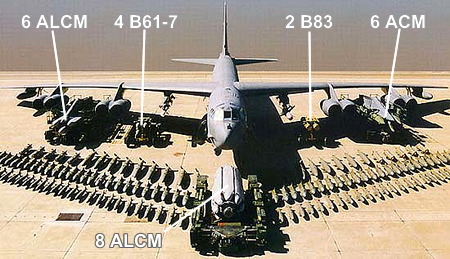 |
| The New START Treaty counts each nuclear bomber as one nuclear weapon even though U.S. and Russian bombers are equipped to carry up to 6-20 weapons each. This display at Barksdale Air Base shows a B-52 with six Air Launched Cruise Missiles, four B-61-7 bombs, two B83 bombs, six Advanced Cruise Missiles (now retired), and eight Air Launched Cruise Missiles. Russian bombers can carry up to 16 nuclear weapons. |
.
The Moscow Treaty attributed real weapons numbers to bombers. The United States defined that weapons were counted as “operationally deployed” if they were “loaded on heavy bombers or stored in weapons storage areas of heavy bomber bases.” As a result, large numbers of bombs and cruise missile have been removed from U.S. bomber bases to central storage sites over the past five years, leaving only those bomber weapons that should be counted against the 2,200-warhead Moscow Treaty limit.
Since the new treaty attributes only one warhead to each bomber, it no longer matters if the weapons are on the bomber bases or not; it’s the bomber that counts not the weapons. As a result, a base with 22 nuclear tasked B-52 bombers will only count as 22 weapons even though there may be hundreds of weapons on the base.
According to U.S. officials, the United States wanted the New START Treaty to count real warhead numbers for the bombers but Russia refused to prevent on-site inspections of weapons storage bunkers at bomber bases. As a result, the 36 bombers at the Engels base near Saratov will count as only 36 weapons even though there may be hundreds of weapons at the base.
If the New START Treaty counting rule is used on today’s postures, then the United States currently only deploys some 1,650 strategic warheads, not the actual 2,100 warheads; Russia would be counted as deploying about 1,740 warheads instead of its actual 2,600 warheads. In other words, the counting rule would “hide” approximately 450 and 860 warheads, respectively, or 1,310 warheads. That’s more warheads that Britain, China, France, India, Israel, and Pakistan possess combined!
| Dodging The Issue |
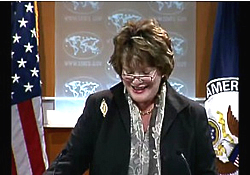 |
|
Update March 30: Ellen Tauscher, the U.S. Under Secretary for Arms Control and International Security, was asked at a press briefing to explain the rationale behind the “fake” bomber warhead counting rule, but dodged the issue: “Well, I think what we want to do right now is talk about why this is an important treaty….” Increased transparency of bomber weapons would greatly improve the importance of the new treaty; the U.S. and Russia have more bomber warheads than the total nuclear weapon inventory of all other nuclear weapon states combined. If they have to use an arbitrary bomber warhead number because it’s too hard to verify, why chose 1? Why not 10 (as START I did) or 12, the medium loading capacity of U.S. and Russian bombers? |
The paradox is that with the “fake” bomber counting rule the United States and Russia could, if they chose to do so, deploy more strategic warheads under the New START Treaty by 2017 than would have been allowed by the Moscow Treaty by 2012.
Force Structure Changes
How the new treaty and the “fake” counting rule will affect U.S. and Russian nuclear force structures depends on decisions that will be made in the near future. In the negotiations both Russia and the United States resisted significant changes to their nuclear forces structures.
Russia resisted restrictions on warheads numbers to keep some degree of parity with the United States. It achieved this by the “fake” bomber weapon count and the delivery platform limit that is higher than what Russia deploys today. Under the New START Treaty, Russia can deploy more strategic warheads on its ballistic missiles than it would have been able to under the Moscow Treaty, although it probably won’t do so due to retirement of older systems. It can continue all its current and planned force structure modernizations.
The United States resisted restrictions on its upload capability, which it achieved by the high limit on delivery platforms. The “fake” bomber count enables more weapons to be deployed on ballistic missiles and more weapons to be retained at bomber bases than would have been possible under the Moscow Treaty. The SLBM-heavy (in terms of warheads) U.S. posture “eats up” a large portion of the 1,550 warhead limit, so the U.S. Nuclear Posture Review soon to be completed will probably reduce the warhead loading on each SLBM, and possible cut about 100 missiles from the ICBM force. The incentive to limit bomber weapons further is gone with the new treaty, although it could happen for other reasons. All current and planned modernizations can continue.
Although Russia has thousands of extra weapons in storage, all its deployed missiles are thought to be loaded to near capacity. As a result, under the New START Treaty, Russia will have little upload capacity. The United States, on the other hand, has only a portion of its available warheads deployed and lots of empty spaces on its missiles. The large pool of reserve warheads available for potential upload creates a significant disparity in the two postures so it is likely that the Nuclear Posture Review will reduce the size of the reserve.
| Estimated U.S. and Russian Strategic Warheads, 2017 |
 |
| Although the New START Treaty reduces the limit for deployed strategic warheads, a “fake” bomber weapon counting rule enables both countries to continue to deploy as many weapons as under the Moscow Treaty. A high limit for delivery vehicles protects a significant U.S. upload capacity, whereas Russia will have essentially none. Future force structure decisions might affect the exact numbers but this graph illustrates the paradox. |
.
Conclusions and Recommendations
The New START Treaty is an important achievement in restarting relations with Russia after the abysmal decline during the Bush administration. And extending and updating the important verification regime creates a foundation for transparency and confidence building.
The treaty will also, if ratified quickly and followed up by additional reductions, assist in strengthening the international nonproliferation regime and efforts to prevent other countries from developing nuclear weapons.
The United States and Russia must be careful not to “oversell” the treaty as creating significant reductions in nuclear arsenals and strategic delivery systems. Although the treaty reduces the limit, the achievement is undercut by a new counting rule that enables both countries to deploy as many strategic warheads as under the Moscow Treaty.
Indeed, the New START Treaty is not so much a nuclear reductions treaty as it is a verification and confidence building treaty. It is a ballistic missile focused treaty that essentially removes strategic bombers from arms control.
The good news is that a modest treaty will hopefully be easier to ratify.
Because the treaty protects current force structures rather than reducing them, it will inevitably draw increased attention to the large inventories of non-deployed weapons that both countries retain and can continue to retain under the new treaty. Whereas the United States force structure is large enough to permit uploading of significant numbers of reserve warheads, the Russian force is too small to provide a substantial upload capacity. Even with a significant production of new missiles, it is likely that Russia’s entire Triad will drop to around 400 delivery vehicles by 2017 – fewer than the United States has today in its ICBM leg alone. That growing disparity makes it imperative that the forthcoming U.S. Nuclear Posture Review reduces the number of delivery vehicles and reserve warheads.
To that end it is amazing to hear some people complaining that the U.S. deterrent is dilapidating and that the United States doesn’t gain anything from the New START Treaty. In the words of one senior White House official, the United States came away as a “clean winner.”
Because the treaty does not force significantly deeper reductions in the number of nuclear weapons compared with the Moscow Treaty, it is important that presidents Obama and Medvedev at the signing ceremony in Prague on 8 April commit to seeking rapid ratification and achieving additional and more drastic nuclear reductions.
See also Ivan Oelrich’s blog.
This publication was made possible by a grant from Carnegie Corporation of New York and Ploughshares Fund. The statements made and views expressed are solely the responsibility of the author.
Judging the Mood at the IAEA
by Ivanka Barzashka and Ivan Oelrich
The latest IAEA report on Iran has been widely touted as containing new evidence of Iranian weapons work and as a sign of the Agency’s new hard-line attitude toward the Islamic Republic under its new Director General Yukiya Amano. We believe the document has been seriously misrepresented in the media and elsewhere, which could have dangerous consequences. We made this argument in a recent op-ed in the Bulletin of the Atomic Scientists.
We should all bother to do a little reading and get our facts straight. If there was a case for new crippling sanctions or for bombing Iran before, the report adds nothing new. The February report contains no new evidence of Iranian weapons work that was not already in the public domain. There is no independent IAEA assessment that Iran currently has or has ever had a nuclear weapons program. This is also hardly the first time that the Agency has addressed outstanding questions pertaining to the possible military dimension of Iran’s nuclear program and has asked for Iran to respond.
Very limited space in our brief Bulletin op-ed did not allow us to address the issue of Amano’s allegedly new tougher tone. The February document, being Amano’s first, has been subject to an exegesis to discern potential attitudes from the director and has been described by Western media as blunt and even confrontational. Inside Iran, the issue of tone has been viewed by some as a “direct result of a change in leadership, and not the outcome of an unbiased evaluation.” (more…)
Testing the No-New-Nuclear-Weapons Pledge
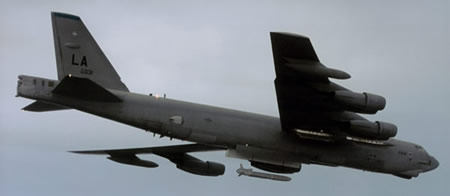 |
| The Air Force is considering a replacement for the nuclear air-launched cruise missile. Will the NPR agree or adhere to Barack Obama’s no-new-nuclear-weapons pledge? |
.
By Hans M. Kristensen [updated March 18, 2010]
One of the important tests of Obama Administration’s nuclear nonproliferation policy will be whether the long-delayed Nuclear Posture Review will approve new nuclear weapons.
During his election campaign, Barack Obama promised not to build new nuclear weapons, a pledge that recently has been reiterated by the administration.
Yet the Air Force’s budget request for 2011 includes several projects that, if approved, would contradict the pledge.
The “No New” Pledge
During the presidential election campaign, Barack Obama pledge to “stop the development of new nuclear weapons” if elected president. The pledged lived on for the first few months after the election on the Obama administration’s White House foreign policy web page, but disappeared when the page was reorganized at the time of the Prague speech in April 2009.
Since the, the president has, to my knowledge, not repeated the pledge. But Under Secretary of State Ellen Tauscher echoed the election pledge last month when she explained that the Pentagon says it does “not need new nuclear weapons capabilities. They just want to be confident in what we have,” she said and declared: “We are not in the business of seeking new nuclear capabilities. They are not needed to preserve a strong, credible deterrent.”
New Nuclear Weapons
Yet “new” seems to be an elusive term. Even though Tauscher promised that the “RRW is dead and is not coming back,” the Air Force nuclear weapons support program includes “Reliable Replacement Warhead (RRW) Studies & Analysis” in both 2010 and 2011. Perhaps she meant RRW as it was known rather than ruling out future replacement warheads. [Update March 18, 2010: The US Air Force now says the reference to RRW studies and analysis is an error and that the item mistakenly was left in the budget request from the previous year]
| More RRW Studies? |
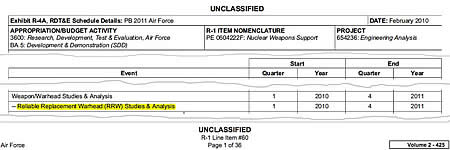 |
| Despite a promise that the “RRW is dead and is not coming back,” the Air Force budget request includes RRW studies and analysis in both 2010 and 2011. Click for larger version. |
.
Another apparent contradictions with the administration’s no new nuclear weapons pledge is a new nuclear cruise missile to replace the current Air Launched Cruise Missile (ALCM) that expires in 2030. The new weapon is known as the Enhanced Cruise Missile (ECM), and development of nuclear weapons requirements documents are planned for 2010 and 2011, along with a Phase 6.2 Study, also known as a Feasibility Study and Option Down Select study. [Update March 18, 2010: The US Air Force now says the reference to the ECM is an error and that the item mistakenly was left in the budget request from the previous year. But the reference to the LRSO is not an error]
| A New Nuclear Cruise Missile? |
 |
| The Air Force budget request includes what appears to be a replacement for the nuclear Air Launched Cruise Missile. Will the NPR approve? Click for larger version. |
.
The Enhanced Cruise Missile appears to be part of a program known as the Follow-On Long Range Stand-Off (LRSO) Vehicle to develop a replacement for the Air Launched Cruise Missile (ALCM).
The plan includes production of the Initial Capabilities Document (ICD) in early 2010, a Material Development Decision (MDD) in September 2010, and an Acquisition Decision in late 2011 or 2012. With that timeline, the NPR will have to make a decision.
New or Modified Warhead
One question is whether the new cruise missile will use a modified version of the existing W80-1 warhead currently deployed on the ALCM for B-52 delivery, or require development of a new warhead.
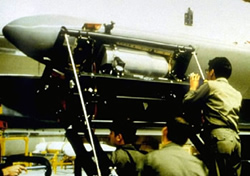 |
| A W80-1 warhead is mated with an ALCM. |
Until 2006, a life extension program (LEP) existed to extend the life of the W80-1. The LEP version was called W80-3. A parallel program to extend the W80-0 warhead would have produced the W80-2. But the Bush administration decided to “defer” the programs in pursuit of the RRW. That effort failed but the W80 LEP is still “archived,” according to the Air Force FY2011 budget request.
The remaining W80-1 warheads are scheduled to receive new neutron generators in 2015-2017, but a refurbishment of the nuclear explosive package is not planned until 2036-2039, according to the NNSA’s FY09 refurbishment planning schedule (no schedule exists yet for FY2010 or FY2011). No life-extension is planned for the W80-0, which will be retired.
| Warhead Refurbishment Plan? |
 |
| The National Nuclear Security Administration’s nuclear warhead refurbishment plan does not include a formal life-extension program for the W80-1 warhead. An expensive program would be added if the NPR approves the Air Force’s cruise missile plan. Chart obtained under FOIA. Click for larger version. |
.
A decision to use a modified version of the existing W80-1 in the new cruise missile would involve reviving the $200 million per year W80-3 LEP program.
New or Just “New”
Nuclear weapons modernization programs risk triggering a contentious debate similar to the dispute over the RRW and whether Obama’s no-nuclear-weapons pledge can be trusted.
Does a new “weapon” refer to the warhead on the missile or the delivery vehicle itself or both? And how new must a weapon be to be considered “new” – does it require an entirely new design or can a modified design be considered a “new” weapon?
Government officials have to be crystal clear when they present the results of the NPR to make sure the administration’s nonproliferation policy doesn’t get stuck in the mud of misunderstandings and contradictions about what constitutes a “new” nuclear weapon. A lot is at stake.
Additional Information: Pentagon Eyes More Than $800 Million for New Nuclear Cruise Missile
This publication was made possible by a grant from Carnegie Corporation of New York and Ploughshares Fund. The statements made and views expressed are solely the responsibility of the author.
Jin SSBN Flashes its Tubes
 |
| One of China’s two Jin-class SSBNs with two open missile tubes. Click for larger image. |
.
By Hans M. Kristensen
One of China’s two new Jin-class SSBNs was photographed with two of its 12 missile tubes open when it visited Xiaopingdao Naval Base in March 2009.
The Jins are being readied to carry the JL-2, a single-warhead regional sea-launched ballistic missile that was most recently test-launched in May 2008. The class may become operational soon and replace the old Xia from 1982.
Xiaopingdao Naval Base, which is where I identified the Jin-class for the first time in 2007, serves as an outfitting and testing facility for new submarines and used to be the homeport of the single Golf-class diesel submarine China used for many years as a test launch platform for its first ballistic missile.
Two or three Jin-class SSBN have been under construction, and it remains to be seen if China will build up to five as projected by U.S. intelligence. China’s nuclear submarines appear to be the noisiest nuclear submarines in the world and will probably be highly vulnerable at sea.
The U.S. Office of Naval Intelligence described in August 2009 that two of China’s SSBNs (probably one Jin and the Xia) were based at the Northern Fleet Base in Jianggezhuang, and the third boat (probably the second Jin) at the Southern Fleet Base on Hainan Island. I identified the Jin at Hainan in February 2008.
The Obama administration’s first version of The Military Power of the People’s Republic of China is expected within the next month or two.
This publication was made possible by a grant from Carnegie Corporation of New York and Ploughshares Fund. The statements made and views expressed are solely the responsibility of the author.
Changing the Nuclear Posture: moving smartly without leaping
Release of the Nuclear Posture Review (NPR) is delayed once again. Originally due late last year, in part so it could inform the on-going negotiations on the Strategic Arms Reduction Treaty Follow-on (START-FO), after a couple of delays it was supposed to be released today, 1 March, but last week word got out that it will be coming out yet another 2-4 weeks later. Some reports are that the delay reflects deep divisions within the administration over the direction of the NPR. That means that there is really only one person left whose opinion matters and that is the president.
We can only hope that President Obama makes clear that he meant what he said in Prague and elsewhere. This NPR is crucial. If it is incremental, if it relegates a world free of nuclear weapons to an inspiring aspiration, then we are stuck with our current nuclear standoff for another generation. This is the time to decisively shift direction. But we should not be paralyzed by thinking that the only movement available is a giant leap into the unknown. We need to move decisively in the right direction, sure, but we can do that in steps. (more…)
Obama and the Nuclear War Plan
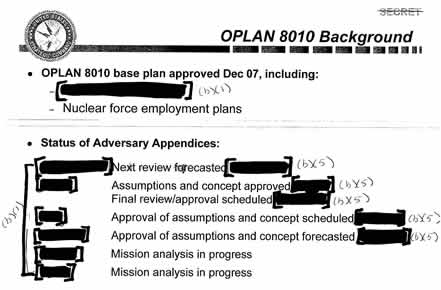 |
| The current U.S. strategic war plan is directed against six adversaries. Guess who. |
.
By Hans M. Kristensen
While the completion of the Obama administration’s Nuclear Posture Review continues to slide, FAS today published an issue paper on how a decision to reduce the role of nuclear weapons might influence the U.S. strategic war plan.
President Obama pledged in his Prague speech last year that he would “reduce the role of nuclear weapons” to “put an end to Cold War thinking,” and reaffirmed earlier this month that the “Nuclear Posture Review will reduce [the] role….”
How to reduce the role in a way that is seen as significant by the global nonproliferation community, visible to adversaries, and compatible with the president’s other pledge to “maintain a safe, secure and effective arsenal to deter any adversary…as long as these weapons exist” apparently is the subject of a heated debate within the administration.
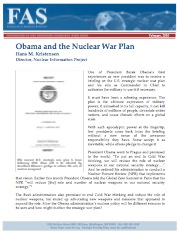 |
| Click image to download report. |
The most persistent rumor is that the review might remove a requirement to plan nuclear strikes against chemical and biological weapons; reduce the mission to the core role of deterring use of other nuclear weapons. I recently described that the Quadrennial Defense Review stated that new regional deterrence architectures and non-nuclear capabilities “make possible a reduced role for nuclear weapons in our national security strategy.”
A reduction of the mission to only deter nuclear use would roll back much of the expansion of nuclear doctrine that happened during the Clinton and Bush administrations. But it would not “put an end to Cold War thinking,” but to post-Cold War thinking.
To put an end to Cold War thinking, the reduced role would have to affect the core of the war plan that is directed against Russia and China.
The issue paper describes how the strategic war plan is structured, how it has evolved, and discusses options for reducing the mission and the war plan itself.
This publication was made possible by a grant from Carnegie Corporation of New York and Ploughshares Fund. The statements made and views expressed are solely the responsibility of the author.
Nuclear Posture Review to Reduce Regional Role of Nuclear Weapons
 |
| The Quadrennial Deference Review forecasts reduction in regional role of nuclear weapons. |
By Hans M. Kristensen
A little-noticed section of the Quadrennial Defense Review recently published by the Pentagon suggests that that the Obama administration’s forthcoming Nuclear Posture Review will reduce the role of nuclear weapons in regional scenarios.
The apparent reduction coincides with a proposal by five NATO allies to withdraw the remaining U.S. tactical nuclear weapons from Europe.
Another casualty appears to be a decision to retire the nuclear-armed Tomahawk sea-launched land-attack cruise missile, despite the efforts of the Congressional Strategic Posture Commission.
New Regional Deterrence Architectures
Earlier this month President Barack Obama told the Global Zero Summit in Paris that the NPR “will reduce [the] role and number of nuclear weapons in our national security strategy.” The reduction in numbers will initially be achieved by the START follow-on treaty soon to be signed with Russia, but where the reduction in the role would occur has been unclear.
Yet the Quadrennial Defense Review (QDR) published earlier this month strongly suggests that the reduction in the role will occur in the regional part of the nuclear posture:
“To reinforce U.S. commitments to our allies and partners, we will consult closely with them on new, tailored, regional deterrence architectures that combine our forward presence, relevant conventional capabilities (including missile defenses), and continued commitment to extend our nuclear deterrent. These regional architectures and new capabilities, as detailed in the Ballistic Missile Defense Review and the forthcoming Nuclear Posture Review, make possible a reduced role for nuclear weapons in our national security strategy.” (emphasis added)
There are two parts (with some overlap) to the regional mission: the role of nuclear weapons against regional adversaries (North Korea, Iran, and Syria); and the role of nuclear weapons deployed in Europe.
Rumors have circulated for long that the administration will remove the requirement to plan nuclear strikes against chemical and biological weapons from the mission; to limit the role to deterring nuclear attacks. Doing so would remove Iran, Syria and others as nuclear targets unless they acquire nuclear weapons. A broader regional change could involve leaving regional deterrence against smaller regional adversaries (including North Korea) to non-nuclear forces and focus the nuclear mission on the large nuclear adversaries (Russia and China).
An immediate consequence of the new architecture appears to be a decision to retire the nuclear Tomahawk sea-launched land-attack cruise missile (TLAM/N). According to a report by Kyodo News (see also report by Daily Yomiuri), Washington has informally told the Japanese government that it intends to retire the weapon. The 2009 Congressional Strategic Posture Commission report had recommended retaining the weapons, but neither the Pentagon nor the Japanese government apparently agreed.
| Nuclear Tomahawk To Be Retired |
 |
| The Obama administration has informally told the Japanese government that the nuclear Tomahawk cruise missile will be retired. The retirement appears to be part of a new regional deterrence architecture that enables a reduction of the role of nuclear weapons. |
.
A Nuclear Withdrawal From Europe?
The other part of the regional mission concerns the deployment of nuclear weapons in Europe, where the U.S. Air Force currently deploys 150-200 nuclear bombs at six bases in five NATO countries. Some of the TLAM/Ns also are earmarked for support of NATO, but are stored on land in the United States. The weapons are the last remnant of the Cold War deployment of thousands of tactical nuclear weapons to deter a Soviet attack on Europe. Similar deployments in the Pacific ended two decades ago and pressure has been building for NATO to finally end the Cold War.
Three of the five NATO countries that currently host the U.S. nuclear bombs on their territories are expected to ask for the weapons to be withdrawn, according to a report by AFP.
A spokesperson for the Belgian Prime Minister said that Belgium, German, and the Netherlands, together with Norway and Luxemburg, in the coming weeks will formally propose within NATO that “that nuclear arms on European soil belonging to other NATO member states are removed.”
Presumably, some coordination with Washington has taken place. Otherwise, if the NPR does not recommend a withdrawal from Europe, the five countries’ initiative will from the outset be in conflict with the Obama administration’s nuclear policy, which NATO likely will follow.
The European initiative would help the Obama administration justify a decision to withdraw the weapons from Europe by demonstrating that key NATO allies no longer see a need for the deployment. Extended nuclear deterrence would continue, as the QDR language underscores, but with long-range strategic weapons as it is done in the Pacific.
Other than the forthcoming NPR, the political context for the European initiative is NATO’s ongoing review of its Strategic Concept, scheduled for completion in November. The Obama administration might not want to preempt that review, so an alternative could be that the NPR concludes that the U.S. sees no need for the continued deployment of nuclear weapons in Europe but leaves it up to NATO’s new Strategic Concept to make the formal decision. In that case, the initiative by the five NATO countries could serve to formally start that process within NATO. (see comments by U.S. NATO Ambassador Ivo Daalder)
Whether that means a complete withdrawal from Europe now, a decision to end the NATO strike portion (a controversial Cold War mission that assigns nuclear weapons for delivery by Belgian, Dutch, German, and Italian aircraft) and consolidating the remaining weapons at one or two U.S. bases in Europe, or something else remains to be seen. But a reduction rather than complete withdrawal would achieve little.
Heated Debate
The debate over the deployment in Europe is in full swing, recently triggered by the new German government’s decision to work for a withdrawal.
A paper by Franklin Miller, a former top-Pentagon official in charge of the deployment in Europe, and former NATO head George Robertson calling the German position dangerous was rejected as old-fashioned thinking on the New York Times’ opinion pages by Wolfgang Ischinger, Germany’s former foreign deputy foreign minister and chairman of the Munich Security Conference, and Ulrich Weisser, a former director of the policy planning staff of the German defense minister.
And suggestions by some supporters of continued deployment that Eastern European countries oppose withdrawal have suffered recently with Poland’s Prime Minister Radek Sikorski calling for the reduction and elimination of non-strategic nuclear weapons, and a report from the Polish Institute of International Affairs in March 2009 that appeared to question the need for the nuclear deployment.
Status of U.S. Nuclear Deployment in Europe
The U.S. Air Force currently deploys an estimated 150-200 U.S. nuclear bombs in 87 aircraft shelters at six bases in five countries, a reduction from approximately 480 bombs in 2001. The breakdown by country looks like this:
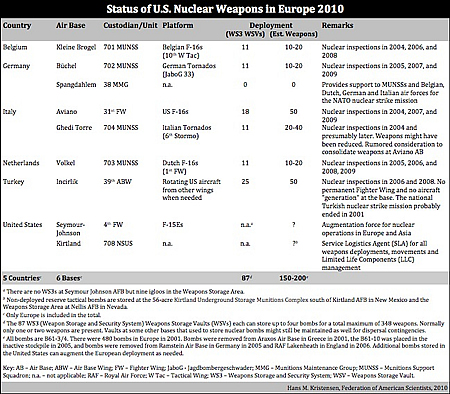 |
| Click image to download larger pdf-version. |
.
Additional Background: History of U.S. Nuclear Weapons in Europe
This publication was made possible by a grant from Carnegie Corporation of New York and Ploughshares Fund. The statements made and views expressed are solely the responsibility of the author.
